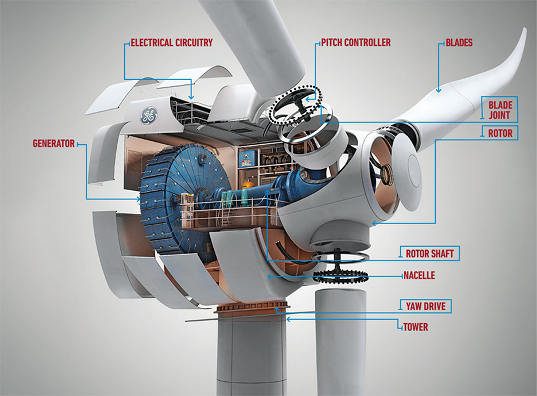What makes a new wind turbine exciting?
Wind companies are always trying to making their next turbine spin more efficiently and generate more power than the last, just as car companies are looking for better fuel efficiency and engine power. Advances usually come in small jumps in both cases, with a single percentage improvement cause for celebration.
GE announced a new line of wind turbines in May that generate between 20 and 24 percent more power than the previous best turbine in its class. It does this through traditional improvements in turbine design, but also through innovations that address one of the main issues that critics of wind power raise: intermittency.
The wind does not blow all the time, and the electric grid needs a regular supply of electricity. Wind has been a critical and climate-friendly addition to the grid portfolio, but as the industry continues to expand, people have started to think about what happens when more and more of our electricity is generated from intermittent renewable sources like wind and solar. Fossil fuel advocates try to make the case that coal and gas (and oil) can be burned constantly, but this is becoming less and less tenable. Rising carbon emissions are triggering extreme weather and sea level rise that endanger the very reliability of the electric grid.
Can advances in technology allow renewable energy sources to be reliable for second-to-second grid use? It’s already happening. In 2011, a concentrated solar plant produced power for 24 hours straight. A huge array of mirrors heated up a huge molten-salt battery system that permitted the solar plant to supply power when the sun was down. Reliable, steady wind energy is also becoming a real thing.
GE’s Brilliant 1.6-100 and 1.7-100 wind turbines are different from previous efforts because they use a short-term, grid-scale battery storage system paired with an “industrial internet” — a sophisticated system that is able to predict when power will be needed and when the wind will be blowing. It’s also bigger. All of this increases efficiency and capacity factor, or how much energy a turbine actually can produce.
This is a big deal, for grid operators and wind energy producers. The Federal Energy Regulatory Commission (FERC) has a rule that requires the people that run the grid to pay more for power that is more reliable and can reach the grid immediately — when demand spikes. Energy providers that take an hour or a few minutes to come online are worth less to those that work to ensure that when you turn on your lights, there is energy ready at hand. Historically, natural gas plants have been more valuable than, say, coal plants because it is easier to get spark a flow of methane to turn a turbine quickly than it is to get a coal furnace hot.
CleanTechnica has an excellent three–part series stemming from their visit to GE’s Research site near Tehachapi, California, with a guided tour into and on top of the GE Brilliant 1.6-100 turbine.
When the wind blows near one of GE’s Brilliant turbines, the “industrial internet” has already done a lot of work to let the power producers and the grid operators know when that energy can be expected. It is able to micromanage the most efficient way to position the turbines for optimal rotation. Still, turbines will produce energy at times that the grid is unable to use it. The battery system attached to the turbine allows it to feed excess electricity into the batteries, converting it to electrochemical energy that the grid can use upon request, with nearly immediate turnaround time.
This also allows the wind turbine operator to get into the frequency regulation business. Frequency regulation is the complex part of grid operation, where second-to-second peaks and valleys in demand obliterate any smoothness in the demand curve. This is ordinarily very difficult and expensive, because entire coal and gas power plants have to be operating full bore on “reserve” capacity to cover for this. But using battery-powered sources to smooth frequency regulation demand is much more efficient — it also allows the grid to dump extra electricity into the battery systems. This is worth more to the grid, and so such systems command nearly twice the price for frequency regulation as thermal (fossil fuel) systems. The U.S. military is already looking into using their growing fleet of electric vehicles on domestic bases to get into the frequency regulation business.
So where are these cutting-edge turbines headed? Sixty-seven of them will be built for installation in the mountains of New South Wales in Australia in the fall of 2013, with power expected to be flowing into the grid by the end of 2014. Fifty-nine of them are headed to the “thumb” region of Michigan as part of a wind farm planned by NextEra Energy Resources. And Invenergy Wind is building a farm in Mills County, Texas that will feature three 2.5 MW GE Brilliant turbines.
As more of these turbines hit the grid, the reliability of renewable energy increases, making it a feasible backbone to the electric grid. And with the cost of the energy produced by these turbines right now level with thermal coal, this seems like a game-changer.










